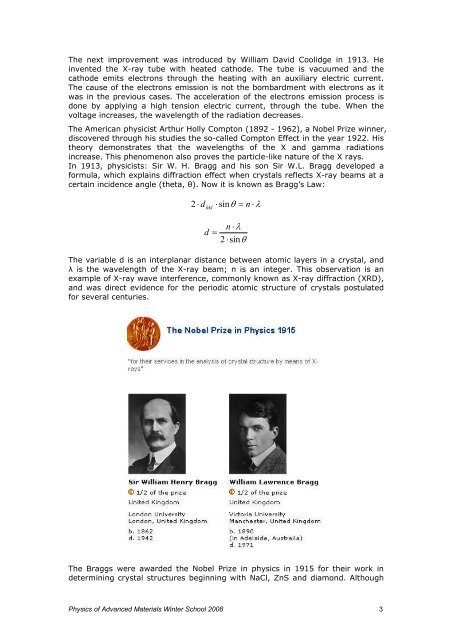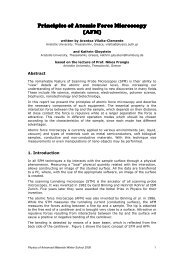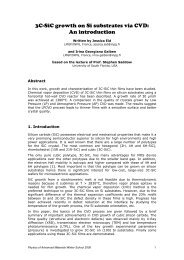The Röntgen Radiation and its application in studies of ... - Mansic
The Röntgen Radiation and its application in studies of ... - Mansic
The Röntgen Radiation and its application in studies of ... - Mansic
You also want an ePaper? Increase the reach of your titles
YUMPU automatically turns print PDFs into web optimized ePapers that Google loves.
<strong>The</strong> next improvement was <strong>in</strong>troduced by William David Coolidge <strong>in</strong> 1913. He<br />
<strong>in</strong>vented the X-ray tube with heated cathode. <strong>The</strong> tube is vacuumed <strong>and</strong> the<br />
cathode em<strong>its</strong> electrons through the heat<strong>in</strong>g with an auxiliary electric current.<br />
<strong>The</strong> cause <strong>of</strong> the electrons emission is not the bombardment with electrons as it<br />
was <strong>in</strong> the previous cases. <strong>The</strong> acceleration <strong>of</strong> the electrons emission process is<br />
done by apply<strong>in</strong>g a high tension electric current, through the tube. When the<br />
voltage <strong>in</strong>creases, the wavelength <strong>of</strong> the radiation decreases.<br />
<strong>The</strong> American physicist Arthur Holly Compton (1892 - 1962), a Nobel Prize w<strong>in</strong>ner,<br />
discovered through his <strong>studies</strong> the so-called Compton Effect <strong>in</strong> the year 1922. His<br />
theory demonstrates that the wavelengths <strong>of</strong> the X <strong>and</strong> gamma radiations<br />
<strong>in</strong>crease. This phenomenon also proves the particle-like nature <strong>of</strong> the X rays.<br />
In 1913, physicists: Sir W. H. Bragg <strong>and</strong> his son Sir W.L. Bragg developed a<br />
formula, which expla<strong>in</strong>s diffraction effect when crystals reflects X-ray beams at a<br />
certa<strong>in</strong> <strong>in</strong>cidence angle (theta, θ). Now it is known as Bragg’s Law:<br />
2 ⋅ d hkl ⋅ s<strong>in</strong>θ<br />
= n ⋅ λ<br />
⋅ λ<br />
=<br />
2 ⋅s<strong>in</strong>θ<br />
n<br />
d<br />
<strong>The</strong> variable d is an <strong>in</strong>terplanar distance between atomic layers <strong>in</strong> a crystal, <strong>and</strong><br />
λ is the wavelength <strong>of</strong> the X-ray beam; n is an <strong>in</strong>teger. This observation is an<br />
example <strong>of</strong> X-ray wave <strong>in</strong>terference, commonly known as X-ray diffraction (XRD),<br />
<strong>and</strong> was direct evidence for the periodic atomic structure <strong>of</strong> crystals postulated<br />
for several centuries.<br />
<strong>The</strong> Braggs were awarded the Nobel Prize <strong>in</strong> physics <strong>in</strong> 1915 for their work <strong>in</strong><br />
determ<strong>in</strong><strong>in</strong>g crystal structures beg<strong>in</strong>n<strong>in</strong>g with NaCl, ZnS <strong>and</strong> diamond. Although<br />
Physics <strong>of</strong> Advanced Materials W<strong>in</strong>ter School 2008 3




